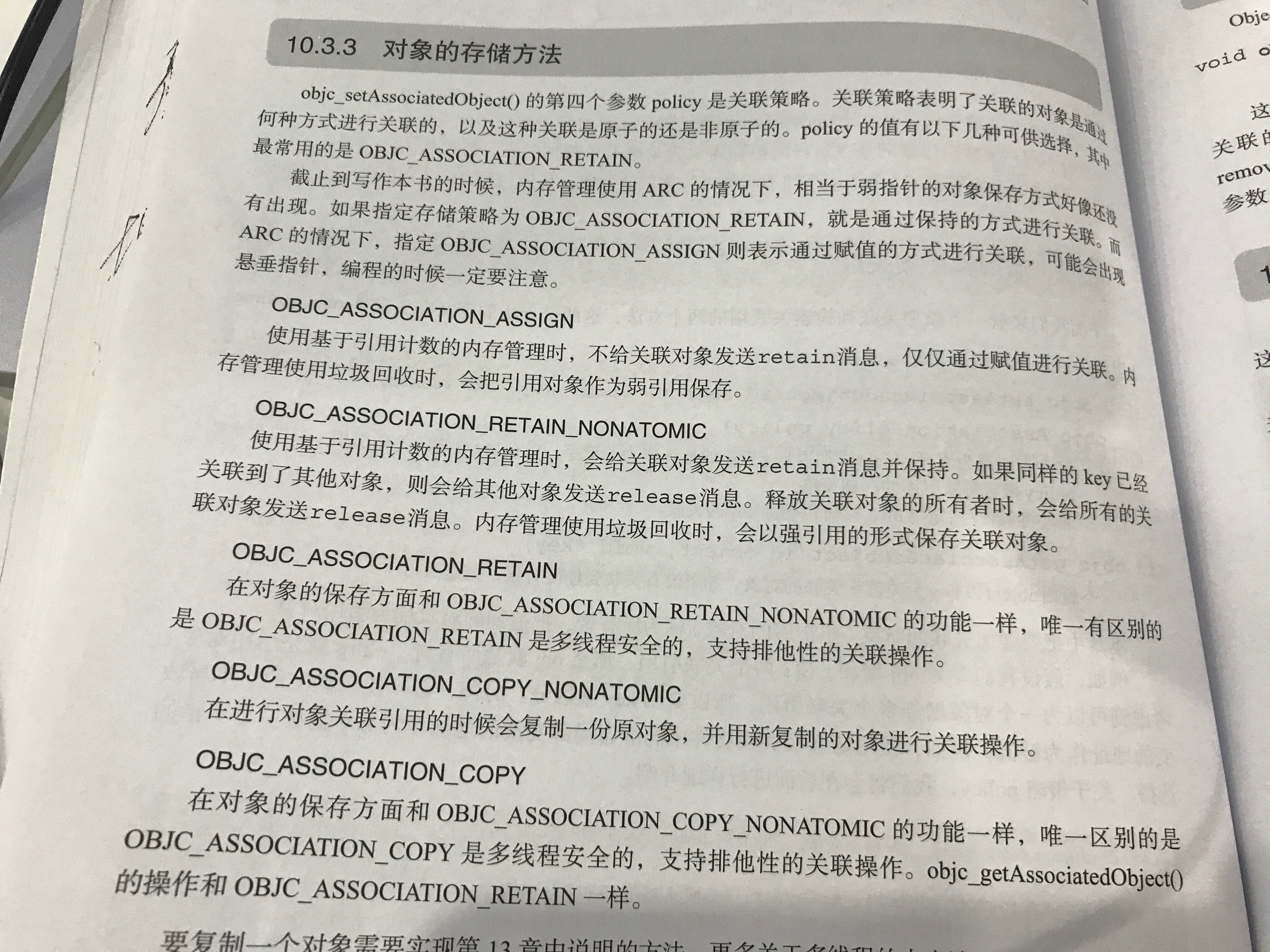Objective-C Associated Objects 的实现原理
我们知道,在 Objective-C 中可以通过 Category 给一个现有的类添加属性,但是却不能添加实例变量,这似乎成为了 Objective-C 的一个明显短板。然而值得庆幸的是,我们可以通过 Associated Objects 来弥补这一不足。本文将结合 runtime 源码深入探究 Objective-C 中 Associated Objects 的实现原理。
在阅读本文的过程中,读者需要着重关注以下三个问题:
- 关联对象被存储在什么地方,是不是存放在被关联对象本身的内存中?
- 关联对象的五种关联策略有什么区别,有什么坑?
- 关联对象的生命周期是怎样的,什么时候被释放,什么时候被移除?
这是我写这篇文章的初衷,也是本文的价值所在。
使用场景
按照 Mattt Thompson 大神的文章 Associated Objects 中的说法,Associated Objects 主要有以下三个使用场景:
- 为现有的类添加私有变量以帮助实现细节;
- 为现有的类添加公有属性;
- 为
KVO创建一个关联的观察者。
从本质上看,第 1 、2 个场景其实是一个意思,唯一的区别就在于新添加的这个属性是公有的还是私有的而已。就目前来说,我在实际工作中使用得最多的是第 2 个场景,而第 3 个场景我还没有使用过。
相关函数
与 Associated Objects 相关的函数主要有三个,我们可以在 runtime 源码的 runtime.h 文件中找到它们的声明:
1 |
|
这三个函数的命名对程序员非常友好,可以让我们一眼就看出函数的作用:
objc_setAssociatedObject用于给对象添加关联对象,传入nil则可以移除已有的关联对象;objc_getAssociatedObject用于获取关联对象;objc_removeAssociatedObjects用于移除一个对象的所有关联对象。
注:objc_removeAssociatedObjects 函数我们一般是用不上的,因为这个函数会移除一个对象的所有关联对象,将该对象恢复成“原始”状态。这样做就很有可能把别人添加的关联对象也一并移除,这并不是我们所希望的。所以一般的做法是通过给 objc_setAssociatedObject 函数传入 nil来移除某个已有的关联对象。
key 值
关于前两个函数中的 key 值是我们需要重点关注的一个点,这个 key 值必须保证是一个对象级别(为什么是对象级别?看完下面的章节你就会明白了)的唯一常量。一般来说,有以下三种推荐的 key 值:
- 声明
static char kAssociatedObjectKey;,使用&kAssociatedObjectKey作为key值; - 声明
static void *kAssociatedObjectKey = &kAssociatedObjectKey;,使用kAssociatedObjectKey作为key值; - 用
selector,使用getter方法的名称作为key值。
我个人最喜欢的(没有之一)是第 3 种方式,因为它省掉了一个变量名,非常优雅地解决了计算科学中的两大世界难题之一(命名)。
关联策略
在给一个对象添加关联对象时有五种关联策略可供选择:
| 关联策略 | 等价属性 | 说明 |
|---|---|---|
| OBJC_ASSOCIATION_ASSIGN | @property (assign) or @property (unsafe_unretained) | 弱引用关联对象 |
| OBJC_ASSOCIATION_RETAIN_NONATOMIC | @property (strong, nonatomic) | 强引用关联对象,且为非原子操作 |
| OBJC_ASSOCIATION_COPY_NONATOMIC | @property (copy, nonatomic) | 复制关联对象,且为非原子操作 |
| OBJC_ASSOCIATION_RETAIN | @property (strong, atomic) | 强引用关联对象,且为原子操作 |
| OBJC_ASSOCIATION_COPY | @property (copy, atomic) | 复制关联对象,且为原子操作 |

其中,第 2 种与第 4 种、第 3 种与第 5 种关联策略的唯一差别就在于操作是否具有原子性。由于操作的原子性不在本文的讨论范围内,所以下面的实验和讨论就以前三种以例进行展开。
实现原理
在探究 Associated Objects 的实现原理前,我们还是先来动手做一个小实验,研究一下关联对象什么时候会被释放。本实验主要涉及 ViewController 类和它的分类 ViewController+AssociatedObjects 。注:本实验的完整代码可以在这里 AssociatedObjects 找到,其中关键代码如下:
1 |
|
在 ViewController+AssociatedObjects.h 中声明了三个属性,限定符分别为 assign, nonatomic、strong, nonatomic 和 copy, nonatomic ,而在 ViewController+AssociatedObjects.m 中相应的分别用 OBJC_ASSOCIATION_ASSIGN 、OBJC_ASSOCIATION_RETAIN_NONATOMIC 、OBJC_ASSOCIATION_COPY_NONATOMIC 三种关联策略为这三个属性添加“实例变量”。
1 |
|
在 ViewController 的 viewDidLoad 方法中,我们对三个属性进行了赋值,并声明了三个全局的 __weak 变量来观察相应对象的释放时机。此外,我们重写了 touchesBegan:withEvent: 方法,在方法中分别打印了这三个属性的当前值。
在继续阅读下面章节前,建议读者先自行思考一下 self.associatedObject_assign 、self.associatedObject_retain 和 self.associatedObject_copy 指向的对象分别会在什么时候被释放,以加深理解。
实验
我们先在 viewDidLoad 方法的第 28 行打上断点,然后运行程序,点击导航栏右上角的按钮 Push到 ViewController 界面,程序将停在断点处。接着,我们使用 lldb 的 watchpoint 命令来设置观察点,观察全局变量 string_weak_assign 、string_weak_retain 和 string_weak_copy 的值的变化。正确设置好观察点后,将会在 console 中看到如下的类似输出:

点击继续运行按钮,有一个观察点将被命中。我们先查看 console 中的输出,通过将这一步打印的 old value 和上一步的 new value 进行对比,我们可以知道本次命中的观察点是 string_weak_assign ,string_weak_assign 的值变成了 0x0000000000000000 ,也就是 nil 。换句话说 self.associatedObject_assign 指向的对象已经被释放了,而通过查看左侧调用栈我们可以知道,这个对象是由于其所在的 autoreleasepool 被 drain 而被释放的,这与我前面的文章《Objective-C Autorelease Pool 的实现原理 》中的表述是一致的。提示,待会你也可以放开 touchesBegan:withEvent: 中第 31 行的注释,在 ViewController 出现后,点击一下它的 view ,进一步验证一下这个结论。

接下来,我们点击 ViewController 导航栏左上角的按钮,返回前一个界面,此时,又将有一个观察点被命中。同理,我们可以知道这个观察点是 string_weak_retain 。我们查看左侧的调用栈,将会发现一个非常敏感的函数调用 _object_remove_assocations ,调用这个函数后 ViewController 的所有关联对象被全部移除。最终,self.associatedObject_retain 指向的对象被释放。

点击继续运行按钮,最后一个观察点 string_weak_copy 被命中。同理,self.associatedObject_copy 指向的对象也由于关联对象的移除被最终释放。

结论
由这个实验,我们可以得出以下结论:
- 关联对象的释放时机与被移除的时机并不总是一致的,比如上面的
self.associatedObject_assign所指向的对象在ViewController出现后就被释放了,但是self.associatedObject_assign仍然有值,还是保存的原对象的地址。如果之后再使用self.associatedObject_assign就会造成 Crash ,所以我们在使用弱引用的关联对象时要非常小心; - 一个对象的所有关联对象是在这个对象被释放时调用的
_object_remove_assocations函数中被移除的。
接下来,我们就一起看看 runtime 中的源码,来验证下我们的实验结论。
objc_setAssociatedObject
我们可以在 objc-references.mm 文件中找到 objc_setAssociatedObject 函数最终调用的函数:
1 |
|
在看这段代码前,我们需要先了解一下几个数据结构以及它们之间的关系:
AssociationsManager是顶级的对象,维护了一个从spinlock_t锁到AssociationsHashMap哈希表的单例键值对映射;AssociationsHashMap是一个无序的哈希表,维护了从对象地址到ObjectAssociationMap的映射;ObjectAssociationMap是一个C++中的map,维护了从key到ObjcAssociation的映射,即关联记录;ObjcAssociation是一个C++的类,表示一个具体的关联结构,主要包括两个实例变量,_policy表示关联策略,_value表示关联对象。
每一个对象地址对应一个 ObjectAssociationMap 对象,而一个 ObjectAssociationMap 对象保存着这个对象的若干个关联记录。
弄清楚这些数据结构之间的关系后,再回过头来看上面的代码就不难了。我们发现,在苹果的底层代码中一般都会充斥着各种 if else ,可见写好 if else 后我们就距离成为高手不远了。开个玩笑,我们来看下面的流程图,一图胜千言:

objc_getAssociatedObject
同样的,我们也可以在 objc-references.mm 文件中找到 objc_getAssociatedObject 函数最终调用的函数:
1 |
|
看懂了 objc_setAssociatedObject 函数后,objc_getAssociatedObject 函数对我们来说就是小菜一碟了。这个函数先根据对象地址在 AssociationsHashMap 中查找其对应的 ObjectAssociationMap 对象,如果能找到则进一步根据 key 在 ObjectAssociationMap 对象中查找这个 key 所对应的关联结构 ObjcAssociation ,如果能找到则返回 ObjcAssociation 对象的 value 值,否则返回 nil 。
objc_removeAssociatedObjects
同理,我们也可以在 objc-references.mm 文件中找到 objc_removeAssociatedObjects 函数最终调用的函数:
1 |
|
这个函数负责移除一个对象的所有关联对象,具体实现也是先根据对象的地址获取其对应的 ObjectAssociationMap 对象,然后将所有的关联结构保存到一个 vector 中,最终释放 vector中保存的所有关联对象。根据前面的实验观察到的情况,在一个对象被释放时,也正是调用的这个函数来移除其所有的关联对象。
给类对象添加关联对象
看完源代码后,我们知道对象地址与 AssociationsHashMap 哈希表是一一对应的。那么我们可能就会思考这样一个问题,是否可以给类对象添加关联对象呢?答案是肯定的。我们完全可以用同样的方式给类对象添加关联对象,只不过我们一般情况下不会这样做,因为更多时候我们可以通过 static 变量来实现类级别的变量。我在分类 ViewController+AssociatedObjects 中给 ViewController 类对象添加了一个关联对象 associatedObject ,读者可以亲自在 viewDidLoad方法中调用一下以下两个方法验证一下:
1 |
|
总结
读到这里,相信你对开篇的那三个问题已经有了一定的认识,下面我们再梳理一下:
- 关联对象与被关联对象本身的存储并没有直接的关系,它是存储在单独的哈希表中的;
- 关联对象的五种关联策略与属性的限定符非常类似,在绝大多数情况下,我们都会使用
OBJC_ASSOCIATION_RETAIN_NONATOMIC的关联策略,这可以保证我们持有关联对象; - 关联对象的释放时机与移除时机并不总是一致,比如实验中用关联策略
OBJC_ASSOCIATION_ASSIGN进行关联的对象,很早就已经被释放了,但是并没有被移除,而再使用这个关联对象时就会造成 Crash 。
在弄懂 Associated Objects 的实现原理后,可以帮助我们更好地使用它,在出现问题时也能尽快地定位问题,最后希望本文能够对你有所帮助。
参考链接
http://nshipster.com/associated-objects/
http://kingscocoa.com/tutorials/associated-objects/
http://blog.csdn.net/u014220518/article/details/52873164
https://www.oschina.net/code/snippet_2248391_52784
DEMO下载:
原文链接:http://blog.leichunfeng.com/blog/2015/06/26/objective-c-associated-objects-implementation-principle/
Objective-C Associated Objects 的实现原理的更多相关文章
- 【引】objective-c,5:Associated Objects 的原理
参考博客: http://blog.leichunfeng.com/blog/2015/06/26/objective-c-associated-objects-implementation-prin ...
- Automake
Automake是用来根据Makefile.am生成Makefile.in的工具 标准Makefile目标 'make all' Build programs, libraries, document ...
- django之模型层
1. ORM MVC或者MTV框架中包括一个重要的部分,就是ORM,它实现了数据模型与数据库的解耦,即数据模型的设计不需要依赖于特定的数据库,通过简单的配置就可以轻松更换数据库,这极大的减轻了开发人员 ...
- AssociatedObject
在 Objective-C 中可以通过 Category 给一个现有的类添加属性,但是却不能添加实例变量,值得庆幸的是,我们可以通过 Associated Objects 来弥补这一不足. 在阅读本文 ...
- SpringBoot:整合Druid、MyBatis
目录 简介 JDBC 导入依赖 连接数据库 CRUD操作 自定义数据源 DruidDataSource Druid 简介 配置数据源 配置 Druid 数据源监控 配置 Druid web 监控 fi ...
- Object Pascal中文手册 经典教程
Object Pascal 参考手册 (Ver 0.1)ezdelphi@hotmail.com OverviewOverview(概述)Using object pascal(使用 object p ...
- Runtime - Associated Objects (关联对象) 的实现原理
主要围绕3个方面说明runtime-Associated Objects (关联对象) 1. 使用场景 2.如何使用 3.底层实现 3.1 实现原理 3.2 关联对象被存储在什么地方,是不是存放在被 ...
- Objective C ARC 使用及原理
手把手教你ARC ,里面介绍了ARC的一些特性, 还有将非ARC工程转换成ARC工程的方法 ARC 苹果官方文档 下面用我自己的话介绍一下ARC,并将看文档过程中的疑问和答案写下来.下面有些是翻译,但 ...
- 78.objects对象所属类原理分析
def index3(request): # 查找文章题目中包含中国的文章分类 category = Category.objects.filter(article__title__contains= ...
随机推荐
- ThinkPHP出现General error: 2006 MySQL server has gone away的解决方法
错误: #13 {main}SQLSTATE[HY000]: General error: 2006 MySQL server has gone awayFILE: \ThinkPHP\Library ...
- 图是否是树 · Graph Valid Tree
[抄题]: 给出 n 个节点,标号分别从 0 到 n - 1 并且给出一个 无向边的列表 (给出每条边的两个顶点), 写一个函数去判断这张`无向`图是否是一棵树. 给出n = 5 并且 edges = ...
- SQLSERVER CROSS APPLY 与 OUTER APPLY 的应用
日常开发中遇到多表查询时,首先会想到 INNER JOIN 或 LEFT OUTER JOIN 等等,但是这两种查询有时候不能满足需求.比如,左表一条关联右表多条记录时,我需要控制右表的某一条或多条记 ...
- 数据备份——PHP
在大多数情况下,开发实在win下进行,因此,然系统每天自动备份数据这也是有必要的饿. Windows平台数据备份 创建批处理文件 在批处理文件中填写如下代码: D:\wamp64\bin\php\ph ...
- 关于删除MySQL Logs的一点记录
五一前,一个DBA同事反馈,在日常环境中删除一个大的slow log文件(假设文件大小10G以上吧),然后在MySQL中执行flush slow logs,会发现mysqld hang住. 今天尝试着 ...
- struts2下velocity做视图如何访问request,session等内置对象,如:原来webwork的$req
struts2下velocity做视图如何访问request,session等内置对象(转) velocity 内置对象 struts2 requestStruts2环境下用velocity做视图时访 ...
- pycharm控制台出现python编译器的编辑功能
一.最近研究了下python,然后昨天发现新建项目后,出现如图的输入状况(Ctrl+Alt+F10) 二 二.更改方式 (1)点开如图位置,进入编辑模式 (2)将如图位置的√去掉就好了
- Oracle学习笔记(十一)
例外: 例外是程序设计语言提供的一种功能,用来增强程序的健壮性和容错性. 例外分为:系统例外自定义例外 系统例外分为:No_data_found(没有找到数据).Too_many_rows(selec ...
- ZOJ3704 I am Nexus Master! 2017-04-06 23:36 56人阅读 评论(0) 收藏
I am Nexus Master! Time Limit: 2 Seconds Memory Limit: 65536 KB NexusHD.org is a popular PT (Pr ...
- 将引用了第三方jar包的Java项目打包成jar文件的两种方法
方案一:用Eclipse自带的Export功能 步骤1:准备主清单文件 “MANIFEST.MF”, 由于是打包引用了第三方jar包的Java项目,故需要自定义配置文件MANIFEST.MF,在该项目 ...
